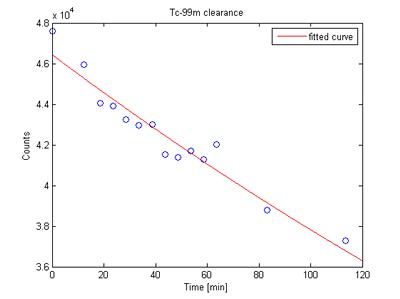We have several projects involving mucociliary clearance measurement. From a disease perspective, these are focused on Primary Ciliary Dyskinesia (PCD) and Chronic Obstructive Pulmonary Disease (COPD).

Mucociliary clearance measurement
Rates of mucociliary clearance can be measured from 2D, planar gamma camera images, taken over a period of time. After allowing for the natural decay of the radioactive isotope used to label the inhaled compound, it is then possible to construct a 'clearance curve', as shown in the example image here. The exponent of the best fit exponential function then gives a quantitative measure of the rate of clearance of the labelled compound from the lung.

It is also possible to compare the rates of clearance from the central and peripheral regions of the lung. This is achieved by dividing the lung region into a series of shells defined by the fractional distance from the hilum. The activity in each shell can then be measured over time, to give a comparison of clearance from the different regions.
Primary Ciliary Dyskinesia
PCD is a genetic condition affecting approximately 3000 individuals in the UK. Cilia are small structures that clear mucus from the respiratory tract. In PCD these do not function properly resulting in repeated chest infections, sinusitis and hearing problems.
The aim of this project is to study the effectiveness of measuring the rate of mucociliary clearance using inhaled, radio-labelled aerosols, as a means of diagnosing PCD. This is currently a pilot study looking at a small number of subjects, which if successful will be used as the basis for a larger study.